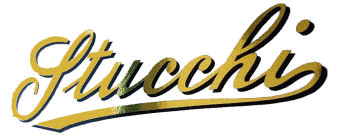




Members wore US Army uniforms but were volunteers. Among those serving was Hemingway who was in Milano at this time. He was twice wounded and was decorated by the Italian government.
A Brief History of the Italian Marque
La Stucchi& C. nata nel 1902 come nuova ragione sociale della Prinetti & Stucchi continua la produzione di biciclette e motocicli.
Viene prodotta una motocicletta monocilindrica con cambio separato e trasmissione finale a cinghia.
Nel primo dopoguerra riprende la costruzione di motociclette tra cui la bicilindrica a V di 1.000 cc con motore MAG.
Nello stesso periodo, fino al 1924 alla 1000 vengono affiancate le cilindrate di 350 e 500cc che rimarrano poi le uniche moto prototte fino al 1926, anno in cui la Stucchi & C. chiuder i battenti.
Interessante ricordare che Adalberto Garelli diresse l’azienda nel periodo bellico.
1910
Rivista mensile del touring club ciclistico italiano, 1910
STUCCHI. - Le motociclette Stucchi sono interamente fabbricate negli stabilimenti Stucchi e C. già Prinetti e Stucchi. Esse sono di tre tipi; di 21/2 HP con accumulatori; di 23/4 HP con
accumulatori e di 2 3/4 HP con magnete : gli ultimi due tipi sono con motori a valvole comandate.
La trasmissione è fatta con cinghia trapezoidale.
Las motocicletas Stucchi fueron fabricadas entre 1901 y 1926 y fueron consideradas a la vanguardia de la tecnología. Inicialmente establecida en Milan en 1874 como “Prinetti y Stucchi”, comienza siendo un pequeño taller mecánico que producía tapones de corcho y luego máquinas de coser. A partir de 1892 comenzó a fabricar bicicletas y en 1898 incursiona con vehículos motorizados de tres y cuatro ruedas tipo “forecar”. Un joven aprendiz de 17 años llamado Ettore Bugatti diseña un triciclo con motor De Dion Bouton y chasis Rochet- Schneider, posteriormente con un modelo bimotor el mismo Bugatti ganará la carrera “Reggio Emilia” y la “Brescia - Verona - Brescia”. En 1901 Giulio Prinetti es nombrado Ministro de Asuntos Exteriores de Italia y abandona la compañía, que pasó a denominarse “Stucchi & C”. Ese mismo año presentan la primera motocicleta, una monocilíndrica con motor Motosacoche de 2¾ HP y en 1905 Carlo Liedi diseña algunos modelos de 3¾ y 4 HP con válvulas laterales y transmisión por correa.
En Mayo de 1914 se celebra en Milán la 1° Exposición Internacional del Motociclismo donde Stucchi presenta dos modelos monocilíndricos de 3 ½ HP (las versiones Turismo y Corsa) y un bicilíndrico de 4 HP.
Durante la Primer Guerra Mundial, Stucchi, junto a Borgo, Bianchi y Frera será uno de los mayores proveedores de motocicletas al Ejército italiano. Stucchi en particular suministra tres modelos: el monocilíndrico de 3½ HP y el bicilíndrico de 6-8 HP, ambos con transmisión primaria a cadena y secundaria por correa. El tercer modelo era otro bicilíndrico de 6-8 HP con transmisión total por cadena para uso con sidecar. Las máquinas tenían carburador Amac, magneto Dixie, caja de tres velocidades, arranque por patada y un ingenioso embrague diseñado por Adalberto Garelli, quien en el período bélico dirigió la fábrica cuando llegó a emplear 1300 trabajadores
Finalizada la guerra Stucchi reanuda la producción ensamblando motocicletas equipadas con motor JAP V-twin de 998 cc con válvulas laterales hasta 1924, pero con escaso éxito comercial, por lo que volvieron a las monocilíndricas de 350 y 500 cc hasta su cierre, en 1926.
Stucchi & C. was created in 1901* when Prinetti & Stucchi was renamed. The firm continued existing production of bicycles and motorcycles, and were considered to be at the forefront of technology. Initially established in Milan in 1874 as "Prinetti & Stucchi", the firm began as a small mechanical workshop that produced wine corks and then sewing machines. From 1892 they began to make bicycles and in 1898 ventured into the burgeoning automotive trade with tricycles and four wheelers.
A young apprentice of 17 years by the name of Ettore Bugatti designed a tricycle with a De Dion Bouton engine and Rochet-Schneider chassis, and later with a twin-engine model on which Bugatti himself won the "Reggio Emilia" and the "Brescia - Verona - Brescia" races.
In 1901 Giulio Prinetti was appointed Foreign Minister of Italy and left the company, which was then renamed Stucchi & C. That same year they presented the first motorcycle powered by a Motosacoche engine of 2¾ h.p., and in 1905 Carlo Liedi designed some models of 3¾ and 4 HP with side valves and belt drive.
In May of 1914 at the first Milan International Motorcycling Exhibition Stucchi presented two single cylinder models of 3½ HP (Turismo and Corsa) and a 4 HP motorcycle.
During the First World War, Stucchi, along with Borgo, Bianchi and Frera, was one of the largest suppliers of motorcycles to the Italian Army. Stucchi in particular supplied three models: the 3½ HP and 6-8 HP bicycle, both with primary transmission chain and secondary belt. The third model was another 6-8 HP motorcycle with transmission per chain for sidecar use. The machine had an Amac carburetor, Dixie magneto, three-speed gearbox, kick starter and an ingenious clutch designed by Adalberto Garelli, who at this time was CEO of the company which had a workforce of 1300.
After the war Stucchi resumed production with a JAP 998cc sidevalve V-twin which they built until 1924, but with little commercial success. Production reverted to 350 and 500cc singles until the firm's closure in 1926.
Stucchi Models
Sources: Moto di Lombardia, Sergio Scalerandi
N.B. Sources give establishment dates of the company as both 1901 and 1902.
If you have a query or information about these vintage Italian machines please contact us